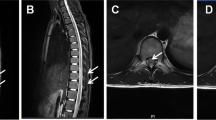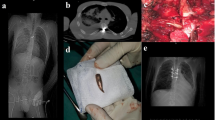Abstract
The aim of this study was to analyze the incidence and the main characteristics of ambulant children with spinal cord injury (SCI) treated at the Unit of Biomechanics and Technical Assistance, at the National Spinal Cord Injury Hospital in Toledo, Spain. To date, there are no detailed studies on the effects of this disease in children regarding their walking ability.
Material and methods
A retrospective study was performed including all patients attending the unit between January 2006 and December 2013, who were aged 18 years or younger and who were outpatients able to walk independently for at least 10 m, with or without technical aids.
Results
Forty-eight patients were included in this study (25 males and 23 females) aged between 2 and 18 years (mean age, 12 ± 2.31 years). The etiology of SCI ranged between congenital (33.33 %), traumatic (29.16 %), and neoplastic (8.33 %), and the level of injury varied between cervical (31.25 %), lumbar (29.16 %), a non-spinal origin (20.83 %), dorsal (16.66 %), and sacral (2.08 %). The mean score on the Barthel Index was 82.61, the mean value of the Functional Independence Measure (FIM) locomotion score was 6.4, and 29 patients did not require the use of walking aids (WISCI 20).
Conclusion
The findings of this study contribute to the knowledge regarding the situation of children with SCI in Spain. The incidence of pediatric SCI is very low; however, the provision of care remains a personal and social challenge.
Similar content being viewed by others
References
Roche C, Carty H (2001) Spinal trauma in children. Pediatr Radiol 31(10):677–700, Review
Cirak B, Ziegfeld S, Knight VM, Chang D, Avellino AM, Paidas CN (2004) Spinal injuries in children. J Pediatr Surg 39(4):607–612
Viccellio P, Simon H, Pressman BD, Shah MN, Mower WR, Hoffman JR (2001) NEXUS group. A prospective multicenter study of cervical spine injury in children. Pediatrics 108(2):20
Jackson AB, Dijkers M, DeVivo MJ, Poczatek RB (2004) A demographic profile of new traumatic SCIs: change and stability over 30 years. Arch Phys Med Rehabil 85:1740–1748
Devivo MJ, Vogel LC (2004) Epidemiology of SCI in children and adolescents. J Spinal Cord Med 27:4–10
Anderson CJ, Vogel LC, Betz RR, Willis KM (2004) Overview of adult outcomes in pediatric onset SCI: implications for transition to adulthood. J Spinal Cord Med 27:98–106
Ditunno PL, Ditunno JF (2001) Walking index for spinal cord injury (WISCI II): scale revision. Spinal Cord 39:654–656
Van Middendorp JJ, Hosman AJ, Poum MH (2009) ASIA impairment scale conversion in traumatic SCI: is it related with the ability to walk? A descriptive comparison with functional ambulation outcome measures in 273 patients. Spinal Cord 47(7):555–560
Keith RA, Granger CV, Hamilton BB, Sherwin FS (1987) The functional independence measure: a new tool for rehabilitation. Adv Clin Rehabil 1:6–18
Cid-Ruzafa J, Damián-Moreno J (1997) Valoración de la discapacidad física: el índice de Barthel. Rev Esp Salud Pública 71(2):127–137
Reynolds R (2000) Pediatric spinal injury. Curr Opin Pediatr 12(1):67–71
Hu R, Mustard CA, Burns C (1996) Epidemiology of incident spinal fracture in a complete population. Spine 21(4):492–499
Palazón García R, Benavente Valdepeñas A, Tamayo Izquierdo R, Morán Feliz E (2007) Rehabilitación en lesionados medulares tras el alta hospitalaria. Rehabilitación 41(2):73–80
Claret Teruel G, Trenchs Sáinz de la Maza V, Palomeque Rico A (2006) Lesión medular aguda en edad pediátrica. An Pediatr 65(2):162–165
Parent S, Mac-Thiong JM, Roy-Beaudry M, Sosa JF, Labelle H (2011) Spinal cord injury in the pediatric population: a systematic review of the literature. J Neurotrauma 28(8):1515–1524
Vogel LC, Betz RR, Mulcahey MJ (2012) Spinal cord injuries in children and adolescent. Handb Clin Neurol 109:131–148
Allen DD, Mulcahey MJ, Haley SM, Devivo MJ, Vogel LC, McDonald C et al (2009) Motor scores on the functional Independence Measure (FIM) after pediatric spinal cord injury. Spinal Cord 47(3):213–217
Schottler J, Vogel LC, Sturm P (2012) Spinal cord injuries in young children: a review of children injured at 5 years of age and younger. Dev Med Child Neurol 54(12):1138–1143
Gorzkowski J, Kelly EH, Klaas SJ, Vogel LC (2011) Obstacles to community participation among youth with spinal cord injury. J Spinal Cord Med 34(6):576–585
Mukhida K, Sharma MR, Shilpakar SK (2006) Pediatric neurotrauma in Kathmandu, Nepal: implications for injury management and control. Childs Nerv Syst 22(4):352–362
Coker P, Karakostas T, Dodds C, Hsiang S (2010) Gait characteristics of children with hemiplegic cerebral palsy before and after modified constraint-induced therapy. Disabil Rehabil 32(5):402–408
Bernthal NM, Gamradt SC, Kay RM, Wren TA, Cuomo AV, Reid J et al (2010) Static and dynamic gait parameters before and after multilevel soft tissue surgery in ambulating children with cerebral palsy. J Pediatr Orthop 30(2):174–179
Vogel LC, Lubicky JP (1995) Ambulation with parapodia and reciprocating gait orthoses in pediatric spinal cord injury. Dev Med Child Neurol 37(11):957–964
Vogel LC, Lubicky JP (1997) Pediatric spinal cord injury issues: ambulation. Top Spinal Cord Inj Rehabil 3(2):37–47
Vogel LC, Mendoza MM, Schottler JC, Chlan KM, Anderson CJ (2007) Ambulation in children and youth with spinal cord injuries. J Spinal Cord Med 30(Suppl 1):158–164
Smith P, Hassani S, Reiners K, Vogel LC, Harris GF (2004) Gait analysis in children and adolescents with spinal cord injuries. J Spinal Cord Med 27(Suppl 1):44–49
De Groot JF, Takken T, Schoenmakers MA, Tummers L, Vanhees L, Helders PJ (2010) Reproducibility of energy cost of locomotion in ambulatory children with spina bifida. Gait Posture 31(2):159–163
Author information
Authors and Affiliations
Corresponding author
Rights and permissions
About this article
Cite this article
Pérez- de la Cruz, S., Cimolin, V. & Gil-Agudo, A. Spinal cord injury in pediatric age in Spain. Reality of a national reference center. Childs Nerv Syst 31, 917–921 (2015). https://doi.org/10.1007/s00381-015-2681-y
Received:
Accepted:
Published:
Issue Date:
DOI: https://doi.org/10.1007/s00381-015-2681-y




